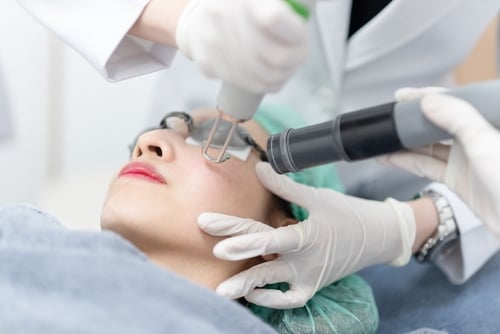Pico laser treatment has gained significant attention in recent years as a revolutionary approach to skin health. Unlike traditional laser treatments, pico lasers operate on a unique principle that enhances skin rejuvenation with minimal downtime. This article explores everything you should know about Pico Laser Treatment in Dubai, including how it works, its benefits, potential side effects, and more.
Understanding Pico Laser Technology:
What is Pico Laser?
Pico laser is a type of laser therapy that uses ultra-short pulses of energy measured in picoseconds (one trillionth of a second) to target various skin concerns. This technology allows for more precise treatment compared to traditional lasers, which operate on nanosecond pulses. The pico laser's quick pulses minimize heat damage to surrounding tissues, making it an effective option for sensitive skin.
How Does It Work?
The pico laser emits energy in short bursts that create a photoacoustic effect. This effect breaks down pigment particles and stimulates collagen production without damaging the skin's surface. The treatment can target a range of skin issues, including hyperpigmentation, acne scars, wrinkles, and uneven skin tone.
Benefits of Pico Laser Treatment:
Effective for Various Skin Concerns:
Pico laser treatment is versatile and can address several skin conditions, including:
- Hyperpigmentation: Effective in reducing dark spots and melasma.
- Acne Scarring: Helps improve the appearance of scars left by acne.
- Fine Lines and Wrinkles: Stimulates collagen production, which can reduce signs of aging.
- Tattoos: Efficient in breaking down tattoo ink, making removal easier.
Minimal Downtime:
One of the major advantages of pico laser treatment is the minimal downtime associated with it. Unlike traditional laser treatments, which may require days of recovery, patients can often resume their normal activities immediately after a pico laser session. Some may experience mild redness or swelling, but this typically subsides within a few hours.
Safe for All Skin Types:
Pico lasers are generally considered safe for all skin types, including darker skin tones that are often more susceptible to complications from traditional lasers. This makes it a suitable option for a broader range of patients.
Reduced Risk of Side Effects:
Due to the shorter pulse duration and lower heat generation, pico laser treatments carry a reduced risk of side effects such as burns, scars, or prolonged redness. Patients often report fewer complications compared to traditional laser procedures.
Quick Treatment Sessions:
Pico laser treatments are relatively quick, usually lasting between 20 to 30 minutes, depending on the area being treated. This makes it an ideal option for individuals with busy schedules seeking effective skin rejuvenation.
The Treatment Process:
Initial Consultation:
Before undergoing pico laser treatment, patients should schedule an initial consultation with a qualified dermatologist or skincare professional. During this consultation, the practitioner will evaluate the patient's skin concerns, medical history, and treatment goals to create a personalized treatment plan.
Treatment Sessions:
Pico laser treatment usually involves multiple sessions to achieve optimal results. The number of sessions required will depend on the specific skin concern being addressed. Typically, patients may need anywhere from three to six sessions, spaced a few weeks apart.
Post-Treatment Care:
After a pico laser session, patients are advised to follow specific aftercare guidelines to ensure optimal healing and results:
- Avoid Sun Exposure: Sun protection is crucial. Patients should use sunscreen with a high SPF to protect the treated area from UV damage.
- Moisturize: Keeping the skin moisturized helps promote healing.
- Avoid Harsh Products: Patients should refrain from using harsh skincare products or exfoliants for a few days after treatment.
Potential Side Effects:
While pico laser treatment is generally safe, some patients may experience mild side effects, including:
- Redness and Swelling: These are common and typically subside within a few hours to a day.
- Dryness or Flaking: Treated skin may feel dry or flaky as it heals.
- Pigmentation Changes: Some patients may notice temporary changes in skin pigmentation, especially if they do not adhere to sun protection guidelines.
Comparing Pico Laser with Other Treatments:
Pico Laser vs. Traditional Laser Treatments:
Traditional laser treatments often use longer pulse durations, which can lead to more significant downtime and discomfort. In contrast, pico lasers offer a more comfortable experience with less recovery time. Additionally, pico lasers can effectively treat a wider range of skin concerns without the risk of significant side effects.
Pico Laser vs. Chemical Peels:
Chemical peels and pico lasers are both effective for skin rejuvenation, but they work differently. Chemical peels involve applying a solution that exfoliates the skin, while pico lasers utilize light energy to target deeper skin layers. Pico lasers can treat deeper issues like acne scars without the prolonged downtime associated with deeper chemical peels.
Conclusion:
Pico laser treatment has revolutionized the approach to skin rejuvenation, offering an effective and safe solution for various skin concerns. With minimal downtime and reduced risks, it's an appealing option for those seeking to improve their skin's appearance. If you are considering pico laser treatment, consult with a qualified dermatologist to determine if it is the right choice for your skin health journey.





Comments